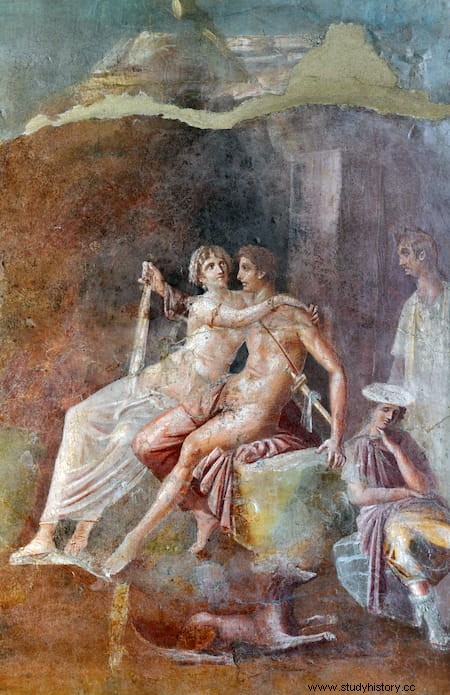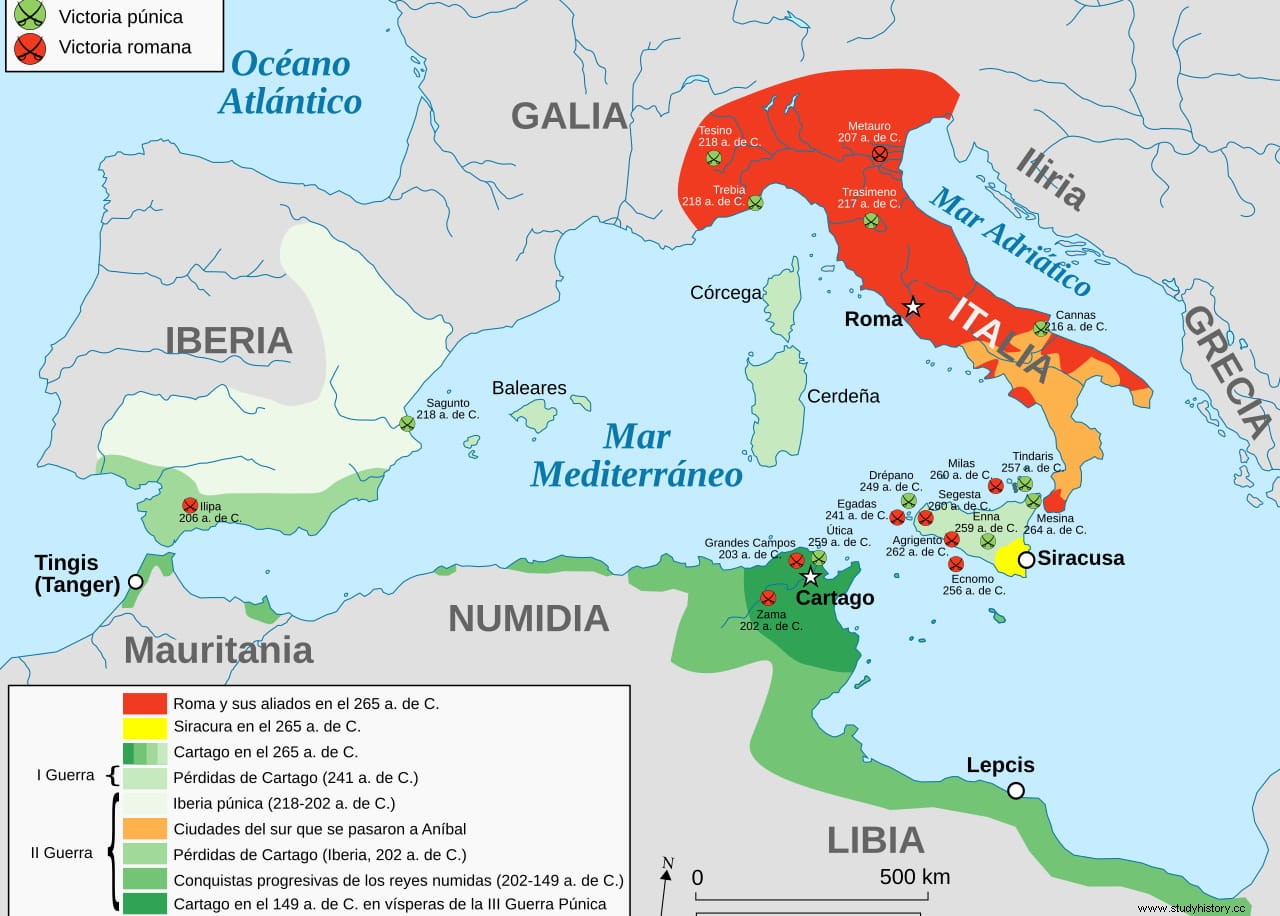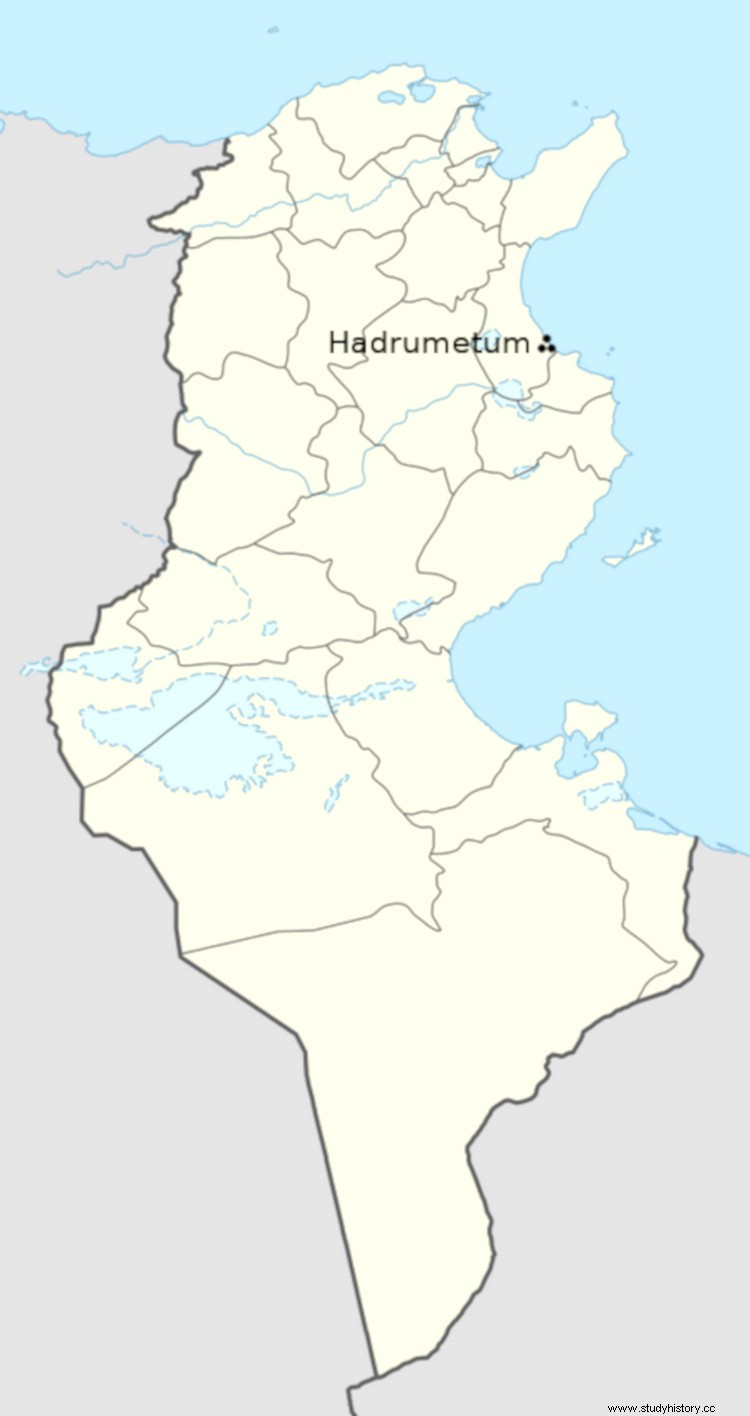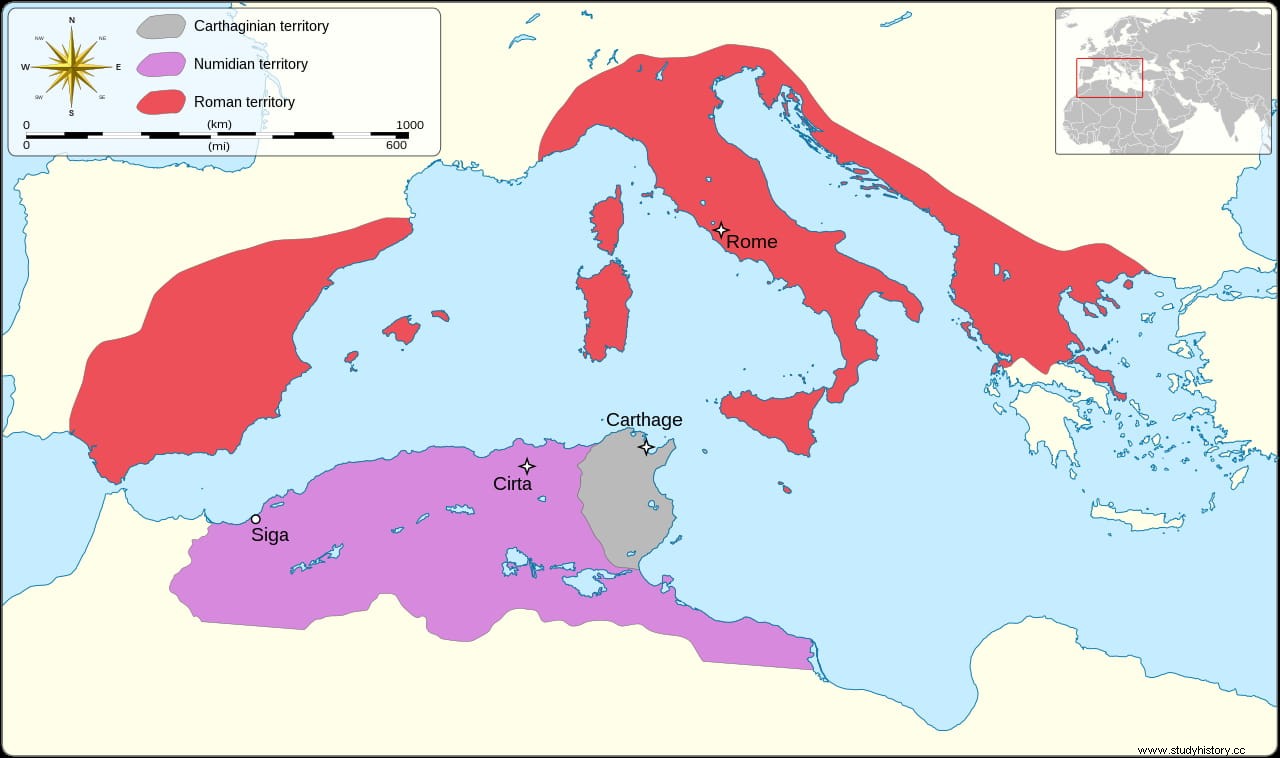If you take a look at the map of the Third Punic War, which represents the territories dominated by the contenders, three large blocks will be observed:the Roman, the Numidian - an ally of the previous one - and the Carthaginian. But although the latter is shown in a uniform way, in reality it would be necessary to place some discordant points in it:one of them would be that of the city of Hadrumeto, the current Tunisian Susa, which despite being Punic decided to support Rome in the contest.
Few will be those who have not heard the legend about the foundation of Carthage. It says that it was the work of a Phoenician princess named Elisa, daughter of Matán I, king of Tyre. She had been forced by her brother Pygmalion to marry Sichaeus, priest of the Melqart temple, to find out where she hid her vast treasures, but she, realizing this ruse, lied that they were buried under the altar. Pygmalion ordered Siqueo to be destroyed and the place to be excavated, resulting in nothing being found there. When she saw the body of her husband, Elisa dug up the treasure, which was in the garden, and fled from Tire with her sister Anna and a small entourage.
Sailing southwest, the flotilla reached the land of the Getulus, petitioning King Jarbas for some land to settle on. The monarch promised her as much as an ox skin could encompass, so Elisa had one cut into long, thin strips that formed a wide perimeter on the hill she called Birsa ("ox skin"), a promontory between the lake of Tunisia and the Sebkah er-Riana lagoon. That place, where she built a fortress and reigned under the name of Dido, was the germ of the future Qart Hadašt, that is, the new city, Carthage. It was the year 814 BC

According to legend, years later Dido was visited by ships also fleeing from his homeland. In this case of Troy, since they were the people of Aeneas, with whom the queen fell in love through Venus, who had reached an agreement with Juno to prevent the Trojan from reaching the Italian peninsula and founding Rome. Only the intervention of Mercury, sent by Jupiter, persuades Aeneas of what his destiny is, so he embarks and leaves, thus leaving Dido desolate, who takes her own life; the rancor generated by it predicted the future enmity of the Romans. Virgil tells it more artfully in The Aeneid .
Another version of the myth says that Dido took her own life when the Phoenician nobles wanted to force her to marry Jarbas. It does not matter because, of course, the historical facts were more prosaic. Carthage was the fruit of the expansion through the Mediterranean that from the end of the third millennium B.C. they carried out Tyre, Sidon and other Punic cities, seeking markets to the west, away from the constant threat posed by the Persian empire. This is how they became skilled navigators who established maritime routes and made agreements with the inhabitants of the lands who found the location of commercial factories.
Over time, these factories grew and ended up becoming colonies. There were many in Sardinia, Malta, Sicily, Ibiza and the Iberian Peninsula, but it was on the North African coast that Carthage grew, its true founding date being between 846 and 813 BC. and becoming the most thriving. Something that led it to become the capital of an authentic empire after the conquest of the metropolis, Tyre, by the Babylonian Nebuchadnezzar II in the first half of the 6th century BC

Obviously, the growing power of Carthage ended up facing the rivals that were emerging, first Greeks and then Romans. The latter, in turn, had been developing as a power from that small settlement in Latium attributed to Aeneas, so that they ended up colliding with the Carthaginians to determine which of the two dominated the western Mediterranean. There only seemed to be room for one.
As we know, the conflict was resolved in the so-called Punic Wars, which were three. The first lasted twenty years and ended badly for Carthage, which was expelled from Sicily and Sardinia, in addition to suffering another war on its own soil against the mercenaries it had hired to fight Rome. The second was caused by the Punic decision to increase its presence in Hispania to take advantage of its mining wealth and compensate for the losses, but the siege of Sagunto, a city allied with Rome, unleashed the confrontation again; it was Hannibal's campaign and it also lasted two decades, ending with another Carthaginian defeat.
This time the conditions imposed by the victors were very harsh:loss of Hispanic possessions, delivery of the fleet -except ten ships-, compensation of ten thousand talents and prohibition of remilitarization. However, the peace was tenuous because the very existence of Carthage was considered a danger by the Romans, many of whom called for its destruction (Cato's famous phrase "Carthago delenda est" ), and because Hannibal was still alive, since he had managed to escape after his defeat at Zama in 202 BC. This is where it's time to talk about Hadrumeto.

Hadrumeto was also born as a Phoenician colony and even before Carthage, because although the chronology is not exact, we do know that it dates back to the 9th century BC, after the foundation of a first commercial factory on the coast of Utica, dated around the year 1100 BC However, despite its Punic character and the domination of its neighbors, Hadrumeto remained more or less independent thanks to the activity of its dynamic port, as the abundance of commemorative stelae in honor of the god Baal Hammon (the main deity) seems to reveal. Phoenician, lord of the winds and fertility, assimilated to the classic Chronos and Saturn).
Located a hundred kilometers south of Carthage, Hadrumeto enjoyed a strategic position to connect Tire with the colony of Gadir and the Pillars of Hercules (the Strait of Gibraltar), but also with Sicily and all those territorial possessions that the Punics enjoyed before their losses. However, the fact that it was autonomous does not mean that it was exempt from being in the orbit of Carthaginian influence, which is why already during the third of the Sicilian Wars, the one that confronted Carthage with the polis of Magna Graecia (Sicily), Hadrumeto suffered an invasion by the army of Agathocles.

The first of these disputes, in 480 BC, had its origin in the attempt of Gelon, tyrant of Syracuse, to unify the island under his command. Carthage tried to prevent it with an expedition led by Amílcar Magón, who was defeated at Himera although the war ended in a draw; yes, the Carthaginian monarchy was weakened and lost power to a republican regime. The Second Sicilian War began seventy years later with the attempt of a renewed and powerful Carthage to control all of Sicily; it failed and was constrained to the extreme southwest of the island in 340 BC.
The third began in 315 BC, when Agathocles, tyrant of Syracuse, took over all the Carthaginian colonies on the island and the Punics responded forcefully by conquering most of the island and besieging Syracuse. Agathocles, desperate, decided to take the operations to enemy soil and in 310 he conquered Hadrumeto, which served as a base to besiege Carthage. He could not, but he remained master of northern Tunis for two years, until finally he had to re-embark and sign a treaty by which he lost Messina and other cities, although he kept Syracuse.
Hadrumeto could not avoid other later episodes either, in the case of the Pyrrhic or Punic wars. And here we pick up the thread of Hannibal's defeat at Zama. He chose the city - just as Scipio later did - because already a year before, in 203 BC, when he returned from his Italian campaign, he used it as a center where he reorganized his forces to face Scipio; after all, it was a safe place, effectively defended by a six-and-a-half kilometer walled perimeter, part of which can still be seen today, and a port with an inner dock. El Barca went from there to Carthage to lead the reconstruction of it from his position as suffeta (magistrate). His good work led the Romans to demand his departure in 195 BC.
But that was not enough to reassure a Rome that was suspicious of the Carthaginian resurgence, which is why it deliberately provoked the Third Punic War. Due to the treaty signed with the Romans, Carthage had the double obligation to recognize the kingdom of Numidia and not to carry out war operations without permission, so that when an army under the command of Hasdrubal the Beotarch tried to repel -unsuccessfully, by the way- a Numidian raid in 151 BC, Rome obtained an ethereal but timely casus belli , rejecting any negotiation and even offered unconditional surrender, demanding to move the city several kilometers inland, which was rejected.

Eighty thousand men added up to the legions landed in Utica, a city that was at the mouth of the Medjerda River, a few kilometers above Carthage and considered the first Phoenician colony in the region, despite which it had already supported Rome in the previous contest for commercial rivalry with its neighbors. Support for the Romans earned Utica the reward of extending its domains to Hippo in the north and Carthage in the south.
Hadrumeto followed the same policy, allowing its inhabitants to escape the terrible fate that befell the Carthaginians in 146 BC, when their city finally fell. The invaders managed to breach the walls and penetrated destroying house by house until they reached the citadel of Birsa, where they took the treasure of the temple and found the last fifty thousand survivors as refugees. They would all be sold into slavery; They did not get to see how their houses were demolished and, according to a dubious tradition, the land was salted.
The region became a Roman province in which the cities that agreed not to intervene were favored and declared free. Útica was designated capital and Hadrumeto, included among the seven civitates liberae , also expanded its area of influence, being able to elect its own senate and minting money. A century later it was involved in the civil war between Julius Caesar and Pompey, being occupied by the two legions of the Pompeian general Cayo Considio Longo, but Caesar recovered it, of whom Suetonius tells an anecdote during his landing:a stumble made him fall to the ground and pick up a handful of sand saying «I have you Africa !” (Now I have you, Africa!).

Hadrumeto therefore changed hands and continued to prosper thanks to the fertility of its lands, becoming an appreciated granary for the metropolis and a producer of Sahelian-style amphorae, reaching between twenty and thirty thousand inhabitants. So it continued, even despite leading a revolt in the year 63 AD. against the proconsul Tito Flavio Vespasiano, who was engaged in shady business and earned the nickname of Mulio trading with mules; no one imagined then that he would later be emperor. It would be a later one, Trajan, who granted the city the rank of a colony and its inhabitants Roman citizenship.
It was thus converted into a fully Romanized city, as evidenced by the fact that one of its residents tried to seize the throne at the end of the 2nd century, Clodio Albino. By then Christianity had already taken root, reflected in the numerous mosaics found in its catacombs, as abundant as the poetic epitaphs. One hundred years later, Diocletian's administrative reforms reorganized proconsular Africa by dividing it into three smaller provinces grouped into a diocese:Zeugitana proconsularis (in the north and governed by a proconsul, hence its name), Tripolitania (in the south) and Byzacena (in the middle). Hadrumeto was designated the capital of the latter, which had consular rank.
But everything was going to change in 434, when Genseric's Asdingo Vandals arrived from Hispania in search of the agricultural wealth of those lands. They crossed the Strait of Gibraltar and took over North Africa, establishing their capital in Carthage and effectively forcing Rome to buy their wheat, in addition to taking advantage of the fleet captured in the old Punic city to conquer the Balearic archipelago, Sicily, Corsica and Sardinia. However, the Vandals could hardly maintain that advantageous position for a century.

And it is that the Berber revolts and the very weakness of the kingdom, involved in internal intrigues, encouraged Justinian I to intervene, who incorporated the region into the Eastern Roman Empire and changed the name of the city to Justinianopolis. They were two centuries that ended in the VII, when the same Berber tribes that favored the Byzantine implantation insisted, already Islamized. The Aghlabids, the first dynasty of North African Sunni Muslims (named after Ibrahim I ibn Aglab, the emir of Algeria who led them), drove out the Byzantines, creating a semi-independent Abbasid caliphate.
They moved the capital of Hadrumeto, which they renamed Susa, to El Abasiya (Kairuán), which did not prevent it from experiencing another moment of commercial splendor. Logically they imposed Islam, so the residents suffered another traumatic change in the religious sphere. It was the third, because if first Caracalla and then the Vandals (who were Arian Christians) had already persecuted the Orthodox faith, giving rise to the first local martyrs, Mavilo, Félix de Hadrumento and Victoriano, Susa remained definitively Muslim, like all of North Africa except the Mauritanian kingdom of Altava, which remained Christian for a century.
After the historic urban renaissance (today it exceeds a quarter of a million inhabitants), it left its ancient ruins about ten kilometers from the current city, the acropolis, the tophet (sacred area) and a necropolis with rock-cut burial chambers, while the original port remains unknown. Today, the National Museum of Tunisia (the most important in the country after that of the Bardo in the capital) preserves and exhibits the numerous pieces found from all the cultures that followed one another.
